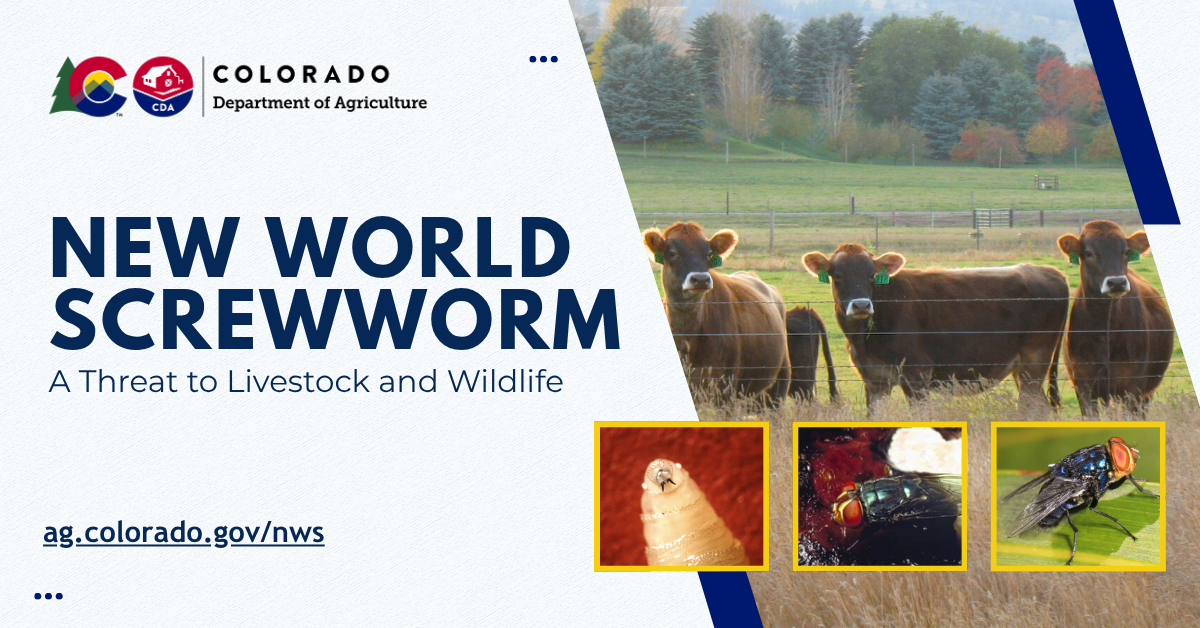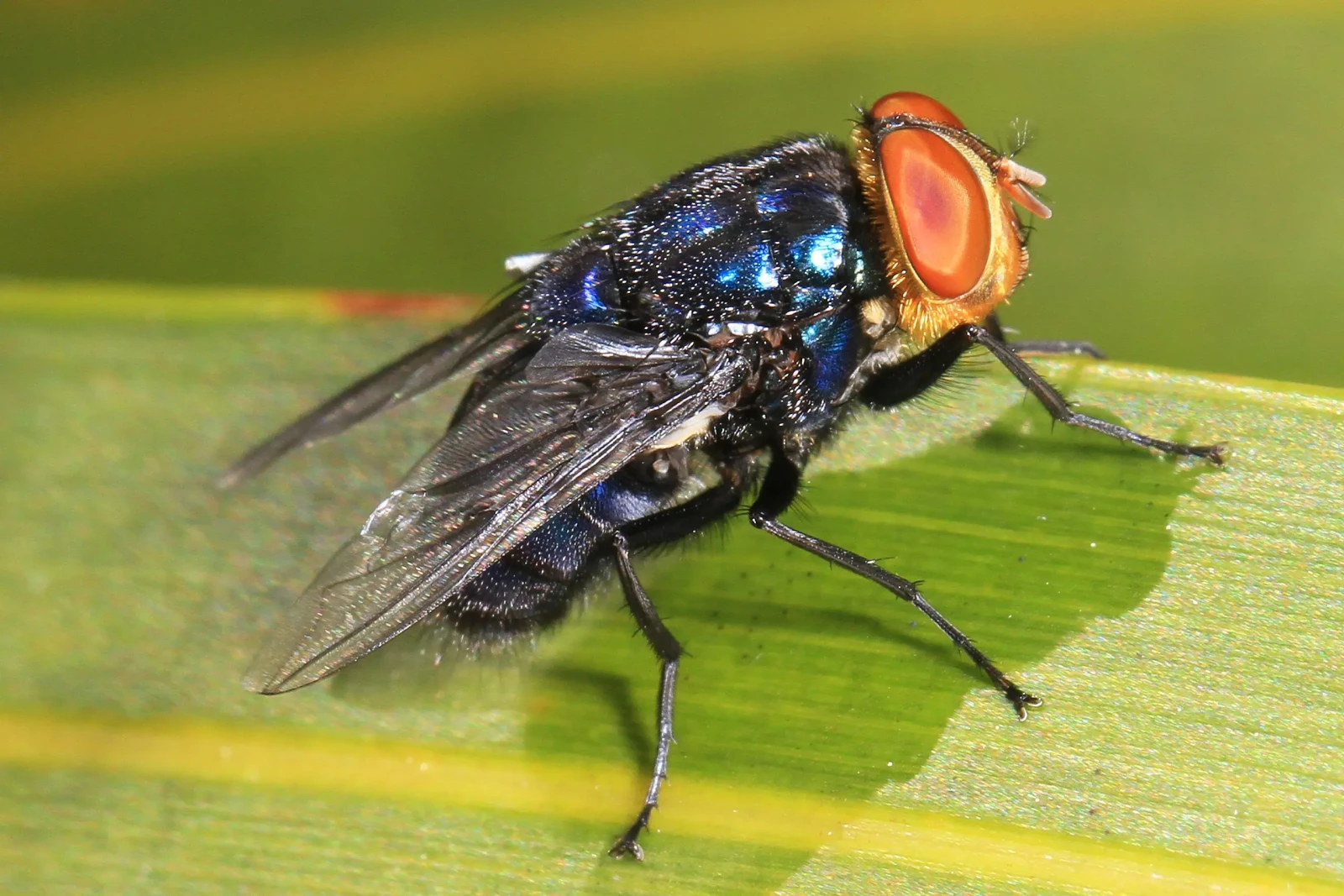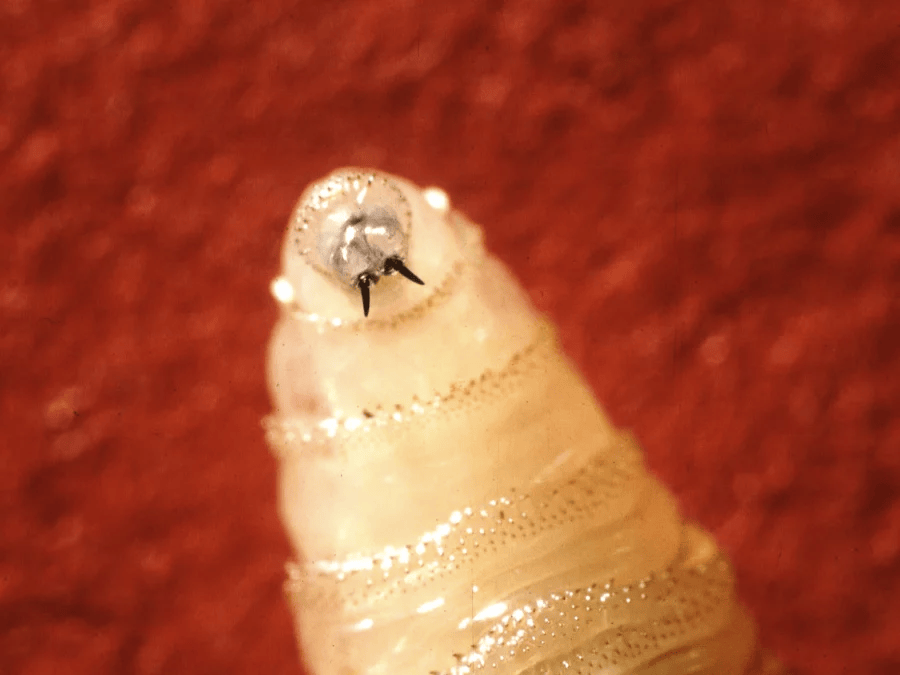New World Screwworm
A Threat to Livestock and Wildlife
Screwworms are parasitic fly larvae that feed on living tissue. There are two main species: the New World Screwworm (NWS - Cochliomyia hominivora) and the Old World Screwworm (OWS - Cochliomyia bezziana). OWS is found in the Eastern Hemisphere, and NWS is found in the Western Hemisphere and is the focus of response activities in Colorado. NWS is a threat to the livestock industry and can cause millions of dollars worth of livestock production losses, economic damage, and eradication efforts.
Adult screwworm flies are slightly larger than a common housefly and have orange eyes, a metallic blue or green body, and three dark stripes along their backs. These pests can infest livestock, pets, wildlife, occasionally birds, and in rare cases, people. They are capable of causing extensive and potentially life-threatening tissue damage to affected animals. The flies are attracted to a variety of open wounds, from tick bites to wounds from procedures like dehorning, where they lay their eggs. The fly larvae then burrow into the wounds feeding on living tissue and causing the wounds to expand and deepen. This infestation of the body of a live animal by fly larvae is called myiasis (my-EYE-a-sis).
NWS has a weather-dependent life cycle, slowing in cooler temperatures and dying in freezing conditions. NWS is primarily found in tropical and subtropical areas and is endemic to Cuba, Haiti, the Dominican Republic, and parts of South America, but was eradicated from the United States in 1966 with the use of the Sterile Insect Technique (SIT).
There are no identified NWS cases in the United States at this time.

Recognizing the Signs
 Key signs in affected animals can include:
Key signs in affected animals can include:
- Irritation and restlessness
- Depression and separating from the herd
- Head shaking
- Decreased appetite & milk production
- The smell of decay
- Expanding, odiferous, or infected wounds
- Evidence of myiasis, also known as fly strike
- Presence of fly larvae (maggots) in wounds
- Larvae feed with their heads buried downwards in the wound
- Only their posterior ends are exposed to the surface
- Spiracles on the posterior end are used to breathe
Photos of infested animals are available on USDA’s webpage.
Sterile Insect Technique
Sterile Insect Technique (SIT) involves the strategic release of irradiated sterile male flies, which then mate with the natural fertile female flies, resulting in non-viable eggs. Female flies typically only mate once, allowing for rapid population eradication.
This technique was used to maintain what is termed a “biological barrier” in eastern Panama beginning in 2006 to prevent NWS populations from moving into screwworm-free areas in Central and North America.
Unfortunately, since 2023, there has been an explosion of cases spreading north of the biological barrier through Central America into Mexico. Up-to-date information tracking this outbreak can be found on the USDA’s New World Screwworm Outbreak in Central America and Mexico page.
Reporting Suspected Cases
New World Screwworm is a reportable disease in Colorado and must be reported upon suspicion of disease to the Colorado State Veterinarian's Office (before it is confirmed by a specialized laboratory).
Owners and Producers
- Animal owners and producers who have general questions about the disease should contact their veterinarian.
Domestic Animals
- Veterinarians, producers, animal owners and diagnostic laboratories, must report any case of myiasis (maggot-infected animals or wounds) in domestic animals to the State Veterinarian’s Office. A case report can be submitted using the Reportable Disease Report Online Submission Form or by contacting our office directly at 303-869-9130.
Wildlife
- To report myiasis cases in wildlife, contact your local Colorado Parks and Wildlife office.

Guidelines for Testing
If you suspect an infection, flies or larvae need to be sent to the National Veterinary Services Laboratory (NVSL) for official identification.
Please contact the Colorado State Veterinarian's Office at 303-869-9130 for submission guidance and assistance.
Sample collection:
- Using forceps, gently remove larvae from several sites and depths within the open wound
- Because secondary myiasis may be present and more common at the surface of the wound, it is important to collect multiple specimens, ensuring some are from the deepest part of the lesion
- If possible, collect larvae of different sizes
- Do not ship live samples for diagnosis
- Place specimens in a vial or test tube that can be tightly closed and preserve the specimens in alcohol (70% ethanol or isopropyl alcohol) at room temperature
- No more than 30ml per container
- Label vial or container with permanent ink
Herd Management Plan
If a detection is made, the Colorado State Veterinarian’s office will work closely with the impacted livestock owner to help prevent any further spread of NWS.
Here are the goals for any impacted herd:
- Eliminate NWS within the affected herd
- Prevent the spread of NWS to other animals and premises
- Minimize the stress and suffering of affected animals
- Ensure proper documentation and reporting
During the response, there are immediate actions a livestock owner will need to take:
- Stop animal movements as directed by the State Veterinarian’s office
- Separate affected animals from unaffected animals
- Undergo a veterinary examination by CDA, APHIS, or an accredited veterinarian under official supervision to examine the herd and assess the extent of infestation, and to collect diagnostic samples
Additionally, we will initiate the treatment for affected animals, herd fly control measures and other biosecurity measures necessary to stop the spread of NWS.
Once the immediate response plan is in action, there will be additional surveillance and monitoring, such as:
- Daily inspections of all animals in quarantined herds
- Fly trapping
- Surveillance of the surrounding premises
Additional Resources
International resources:
- COPEG (Panama – United States Commission for the Eradication and Prevention of Screwworm)
- Outbreak SitRep from Mexico
APHIS:
- New World Screwworm Emergency Response
- Screwworm Biology Distribution and Identification poster (PDF)
- NWS Overview (PDF)
CDC:
FDA:
Merck Manual:
Contact Animal Health
305 Interlocken Parkway
Broomfield, CO 80021
Office Hours: Monday through Friday, 8 am to 5 pm
Phone: (303) 869-9130
Fax: (303) 466-8515
Email: animalhealth@state.co.us
State Veterinarian: Dr. Maggie Baldwin
Assistant State Veterinarian: Dr. Eryn McGrath